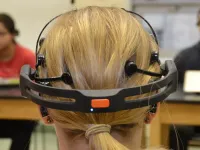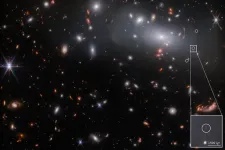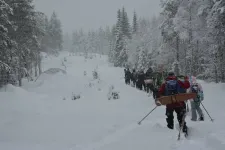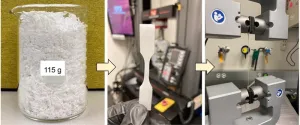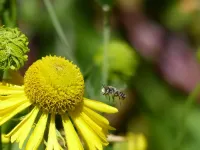(Press-News.org) Most cells evolve slowly, accumulating incremental changes that better suit their environments. Immune cells, because they must adapt rapidly to counter new threats, evolve much more quickly. Part of that, UCLA physicists now report, rests on their ability to forcibly pull antigens off other cells’ surfaces and “study” them.
By using this type of mechanical force, the immune system’s B cells, which create antibodies that fight off harmful pathogens like viruses, bacteria and parasites by targeting their antigens, are able to better gauge the properties of particular antigens, compare which types of cells among the B cell population recognize and respond to each antigen most efficiently, and produce more of those cells.
The discovery that immune cells use mechanical force — in addition to biochemical signaling — in an active, deliberate way to advance their own evolution adds a new paradigm to studies of immune system learning and memory, said Shenshen Wang, a UCLA assistant professor of physics and astronomy and corresponding author of the research.
“We showed that fast-evolving immune cells use tactile sense, by applying active tugging forces, to learn about their antigenic targets and to rank themselves,” Wang said. “Such active physical sensing allows the immune cell repertoire to respond effectively to current challenges while being plastic and adaptive against future threats.”
That cells sense and respond to external physical forces has long been a cornerstone of biology. But the knowledge that they generate their own physical forces to acquire signals is recent, with evolutionary consequences that haven’t been explored until now. Wang said the findings may help scientists figure out how to guide the evolution of the immune system by designing a sequence of vaccines to help it learn to identify and encode the most important features of different antigens. An immune system tuned this way could, for example, recognize and neutralize a virus it has never encountered before much more quickly.
The research is published in two peer-reviewed journal papers. In Proceedings of the National Academy of Sciences, Wang and her co-author, UCLA physics doctoral student Hongda Jiang, describe how B cells pull antigens from the antigen-presenting cells to which they are tethered, generating mechanical stress that propagates through connected cell surfaces and changes the distribution of energy at the points where cells touch each other.
Even when B cells’ attempts to extract an antigen from a particularly stiff antigen-presenting cell are not successful, Wang and Jiang note, the process still enhances B cell learning. More importantly, the deformation of the connected structure by mechanical force increases the amount of time immune cells can “remember” what they’ve learned and extends the range of antigens they can detect. And if pulling gets stronger over time, the detection range expands significantly.
In a paper accepted for publication in the open-access journal Physical Review X, Wang and Jiang address an immune cell dilemma: How the body’s finite set of immune B cells achieves a balance between responding with sufficient strength to antigens they’ve already encountered while also being able to recognize pathogens they’ve never seen before. The new research shows that B cells’ mechanical force–driven evolution improves memory diversity, giving natural immunity greater adaptive potential by balancing the potency of response to antigens with the breadth of coverage.
By opening a wide variety of biophysical pathways to improve antigen-recognition ability, this active process gives the body’s natural immunity more ways to adapt to new mutants and future variants. The authors write that the process works hand-in-hand with biomechanical sensing and biochemical signaling to produce nimble immune systems able to rapidly evolve to cope with new challenges.
“We are proposing a new paradigm of biological recognition via physical acquisition of stimuli, which may complement the current view centered on biochemical signaling,” Wang said. “Meanwhile, it offers a fresh angle for understanding biological adaptation in light of physical influences on evolution. Our findings have broad implications for understanding biological learning and for physically steering adaptive evolution in general, and immune response in particular.”
END
Biological bouncers: How immune cells yank antigens from surfaces to learn and evolve
2023-04-13
ELSE PRESS RELEASES FROM THIS DATE:
OHSU researchers assemble comprehensive atlas of gene mutations in human tissue
2023-04-13
Researchers have created the largest atlas of post-zygotic genome mutations in healthy human tissue ever assembled — a scientific advancement that could unlock new avenues for diagnosing and treating genetic disease. It is the largest ever in terms of the combined number of tissues and number of donors sampled.
The study, led by researchers at Oregon Health & Science University, published today in the journal Science.
The development points the way toward understanding the genetic underpinnings of disease associated with cancer as well as innumerable conditions caused by cellular malfunction, including ...
In sync brainwaves predict learning, study shows
2023-04-13
Students whose brainwaves are more in sync with their classmates and teacher are likely to learn better than those lacking this “brain-to-brain synchrony,” shows a new study by a team of psychology and education researchers. The findings, which appear in the journal Psychological Science, offer new insights into the learning process.
“This is the first study to show that the extent to which students’ and teachers’ brainwaves are in sync during real-world learning can predict how well students retain information from class,” says lead author Ido Davidesco, an assistant professor at the ...
Researchers discover tiny galaxy with big star power using James Webb telescope
2023-04-13
Using first-of-their-kind observations from the James Webb Space Telescope, a University of Minnesota Twin Cities-led team looked more than 13 billion years into the past to discover a unique, minuscule galaxy that generated new stars at an extremely high rate for its size. The galaxy is one of the smallest ever discovered at this distance—around 500 million years after the Big Bang—and could help astronomers learn more about galaxies that were present shortly after the Universe came into existence.
The paper is published in Science, one of the world's top peer-reviewed academic journals.
The University of Minnesota researchers were one of the first teams to study ...
Humans, and piglets, and bears, oh my! Preventing dangerous blood clots
2023-04-13
“Don’t poke the bear”, they said. But that’s exactly what a team of scientists have been doing, to discover the secrets of blood clotting.
Hibernating bears, paralysed humans, and pigs kept in small enclosures all avoid dangerous blood clots, despite being immobile for extremely long periods.
Research from the University of Reading, with partners in Denmark, Germany, Norway and Sweden, shows that reduction of a key protein prevents the formation of blood clots in all three mammal species when they ...
UTSA astrophysicist leads international team in discovery of new exoplanet outside Earth’s solar system
2023-04-13
(SAN ANTONIO) April 13, 2023 - An international research team led by UTSA Associate Professor of Astrophysics Thayne Currie has made a breakthrough in accelerating the search for new planets.
In a paper slated for publication April 14 in Science, Currie reports the first exoplanet jointly discovered through direct imaging and precision astrometry, a new indirect method that identifies a planet by measuring the position of the star it orbits. Data from the Subaru Telescope in Hawai`i and space telescopes from the European Space Agency (ESA) were integral to the team’s discovery.
An ...
Shift to ‘flash droughts’ as climate warms
2023-04-13
Embargoed: Not for Release Until 19:00 (7.00 pm) British Summer Time, Thursday, 13 April 2023
Shift to ‘flash droughts’ as climate warms
‘Flash droughts’ have become more frequent due to human-caused climate change and this trend is predicted to accelerate in a warmer future, according to research published today [13 April 2023] involving the University of Southampton.
The research published in Science shows that flash droughts, which start and develop rapidly, are becoming ‘the new normal’ for droughts, making forecasting and preparing for their impact more difficult.
Flash ...
First Nations populations at greater risk of severe flu, research finds
2023-04-13
First Nations populations at greater risk of severe flu, research finds
Responsible for over 5 million infections and 100,000 deaths every year, influenza remains one of the most challenging public health issues for populations globally, particularly First Nations communities.
New research from the Peter Doherty Institute for Infection and Immunity (Doherty Institute) has found that First Nations populations around the world are significantly more likely to be hospitalised and die from influenza compared to non-Indigenous populations.
Researchers from the Doherty ...
Channeling mechanical energy in a preferred direction
2023-04-13
A research group led by scientists from the RIKEN Center for Emergent Matter Science have developed a unique material, based on nanofillers embedded in a hydrogel, that can channel mechanical energy in one direction but not the other, acting in a “nonreciprocal” way. With this composite material--which can be constructed at various sizes--the team was able to use vibrational up-and-down movements to make liquid droplets rise within a material against gravity. Using this material could thus make it possible to make use of random vibrations and move matter in a preferred direction.
Channeling energy in a preferred direction is an ...
Chemists redesign biological PHAs, ‘dream’ biodegradable plastics
2023-04-13
They’ve been called “dream” plastics: polyhydroxyalkanoates, or PHAs. Already the basis of a fledgling industry, they’re a class of polymers naturally created by living microorganisms, or synthetically produced from biorenewable feedstocks. They’re biodegradable in the ambient environment, including oceans and soil.
But there’s a reason PHAs haven’t taken off as a sustainable, environmentally benign alternative to traditional plastics. Crystalline PHAs are brittle, so not as durable and convenient as conventional plastics. They cannot easily be melt-processed and recycled, making them expensive to produce.
Colorado State ...
Bees flock to clearcut areas but numbers decline as forest canopy regrows, OSU research shows
2023-04-13
CORVALLIS, Ore. – Native bees in the Oregon Coast Range are diverse and abundant in clearcut areas within a few years of timber harvest but their numbers drop sharply as planted trees grow and the forest canopy closes, research by Oregon State University shows.
The findings are important for understanding the roles forest management might play in the conservation of a crucial pollinator group, the researchers said.
The study, led by graduate student Rachel Zitomer and Jim Rivers, an animal ecologist in the OSU College of Forestry, was published in Ecological Applications.
“The research demonstrates ...
